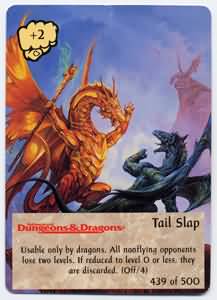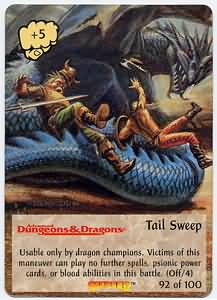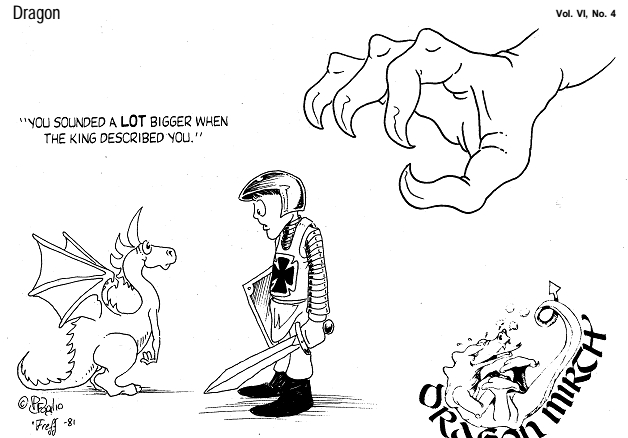| - | - | "Dirty tricks" for Dragons | - | - |
| Dragon | Monsters | Dragons | Best of Dragon, Vol. III | Dragon 50 |
The dragon is nearly everyone’s favorite
monster. There is
something numinous in the name and the
image: sagacious,
fierce, terrible in ifs jaws and claws,
soaring aloft on great pinions, breathing great gouts of flame and smoke.
If such a creature existed in nature, even without fiery breath, its sire,
strength, mobility, and intelligence would
make it a formidable
foe of and competitor with mankind — our
advantage lying only
in numbers and a comparatively rapid rate
of reproduction.
But the dragon is an endangered species.
How can this be?
Just as the dragon is the favorite pet
of the Dungeon Master, if is
the favored prey of the adventurers. Is
the castle on the crag
haunted by a vampire? The characters shudder
and dare the
crag only with trepidation. Do the depths
of the caves hold
demons? Let’s wait until we’re a bit more
skilled... But let word
get out that a dragon lurks or fairs in
the vicinity, and every
character within earshot drops everything
else and begins sharpening sword with dragon in mind. Hirelings of every
stamp are
readily bought with the promise of sharing
in the dragon’s
enormous hoard. When the party has equipped
itself with control potions, all the magic that can be begged, borrowed,
or
stolen, and a train of pack mules to ferry
back the loot, it’s hi-ho
and off they go dragon hunting.
No other monster holds the potential of
such great gain at
such comparatively low risk.
Yes, I said low risk. What other monster
is liable to be found
sleeping obliviously in his den? What
other creature can be so
easily subdued and then sold on the open
market? And even
dead, the dragon alone is worth a sizable
ransom; its hide can be
sold for armor, its teeth for ornament,
its other parts for potions.
All other creatures with spell-using or
magic-like capabilities
have them pretty uniformly throughout
the type. A dragon with
no spell ability has only one other major
weapon: its breath,
which works only three times per day.
The claws of even the
largest gold dragon are no more formidable
than swords, and
many other creatures can approach the
damage of a dragon’s
bite, or possess abilities Iike paralyzation
or life draining that are
continually reusable.
The result is that few dragons are able
to stand up to the
invariably large and well equipped parties
that are thrown
against them. A carefully dispersed party
can avoid the blasts of
breath weapon with a fair chance of survival
by surrounding the
dragon and inflicting unnacceptable damage
on the beast’s
flanks and tail. Even if the dragon were
guaranteed of killing an
adventurer with each bite, a large party
would still overwhelm it
— especially if the dragon was awakened
from sleep by one or
more heavy-damage spells hitting home.
The dragon really ought to be more formidable
in melee, a
veritabte whirlwind of destruction, the
likes of which should
rightly frighten anyone in possession
of all his wits.
The damage done by dragon claws is far
too slight for anything except small representatives of the species.
An average-sized dragon ought to do twice
as much, and a huge dragon
perhaps three times as much. This would
reflect the enormous
strength these creatures possess. The
smallest dragon type, the
white, averages 24 feet in length. Even
if we assume that half of
the dragon’s length is made up of neck
and tail, the dragon
should still have as much mass as a large
elephant. Yet these
creatures have the muscular strength to
fly! Even if it is assumed
that the dragon’s power of flight is due
to an inborn magical
power, akin to the breath weapon, a creature
of that size must be
exceptionally strong to be able to move
with any speed. Therefore, a dragon ought to have at least the muscular
strength of a
comparably sized giant, if not more. Remember,
a giant cannot
fly by muscular strength alone, and if
giants had strength in
human terms in proportion to their size,
they would not even be
able to stand, and support their huge
frames.
Further, dragons have other assets that
are not considered in
combat. Unlike reptiles or saurians, dragons
are hexapedal, or
six-limbed, with the “extra” pair of limbs
being wings. Other
flying creatures, birds, bats, and the
extinct pterosaurs, have
wings made out of modified forelimbs.
Let us assume that, considering neck and
tail, a dragon might
have a winsgspread approximately equal
to its overall length. A
24-foot-long dragon would therefore have
a 12-foot wing on
either side. These wings are often thought
of as bat-like, a
membranous structure supported on a frame
of modified wing
and hand bones. (See the AD&D™ Monster
Manual illustrations
of the white,
silver,
and green dragons, and the dragonne.)
There is often a “thumb” claw at the “hand”
joint. The dragon
Smaug, as pictured in the television version
of The Hobbit, had a
weIl developed thumb and fingers at the
wing-hand, similar to
bats and flying dinosaurs. I personally
prefer this idea.
The point of this discourse on wings is
this: If you have ever
tried to corral a winged creature, a chicken,
or, worse yet, a large
goose, you know that it strikes out with
its wings. Roger Caras,
in his book Dangerous To Man, reports
several instances of fatal
injuries being inflicted by the blows
of a swan’s wings. Therefore, those characters standing to the sides of
the dragon must
dare the sweep of the dragon’s wings.
Those in front and near
the center of the wing would be in danger
of being struck by the
wing-claws. A wing buffet should do some
damage, mainly of a
bruising, battering type, tending to throw
adventurers away
from the dragon, and this should amount
to about one-third of
the dragon's normal claw damage. If the
target is within range of
the wing-claw, add an extra “to hit” roll
for the dragon, and if the
result is a hit, add the appropriate extra
damage, ranging from
1-2 points for a smash dragon to perhaps
1-10 for a big one.
An intelligent dragon might use its wings
in more than one
manner. A dragon with a gaseous breath
weapon could use the
sweep of its wings to fan the gas into
every corner of its lair. A
dragon that has started a fire with its
breath could fan the flames
into a roaring conflagration. A prudent
dragon might cover the
floor of its den with ice crystals, sand,
ash, or other loose material which could be whipped into a blinding, stinging
storm at
the onset of an attack.
On the subject of limbs, what about a dragon’s
hind feet?
Surely any dragon is intelligent enough
to kick out at something
attacking its flank, especially if the
front end is otherwise engaged. Allow one foot stamp by one of a dragon’s
hind feet in
every other set of attacks. (The dragon,
if not actually airborne,
has to stand on at least one foot at all
times, although it might be
supported by its wings to some degree.
This should do the same
damage as the foreclaws, but at -2 to
hit. If the dragon were for
some reason to engage in close combat
with some creature
nearly its own size, such as a giant,
then the dragon might well
employ both rear claws at once, in the
manner of some great
cats, especially jaguars and leopards.
In such attacks, the animal attempts to get the throat of its adversary
in its own jaws,
hooks its claws into the shoulders of
the opponent, and then (in
a dragon’s case with the aid of wings
for lift and balance) brings
the rear claws up to thrust into the midsection
of the victim and
rake downward to disembowel the enemy.
This is the only situation in which a dragon might reasonably be expected
to employ
both rear claws at the same time.
Finally, there is the tail. Many dinosaurs
and present-day
crocodiles and alligators use their powerful
tails as weapons. I
have assigned different types of tails,
reflecting the different
dragon types, in much the same way that
breath weapons might
be differentiated. White and silver dragons
I have given a relatively short, thick tail, with a ridge of horny plates,
that might
give the creature better traction in climbing
on ice. It would
strike against armor as would a mace.
To the traditional firebreathing dragons, the red and the gold, I assign
a traditional
dragon’s tail, long and tipped with a
spadelike blade. It would
strike against armor as does a sword.
Green and brass dragons
have a tail of medium length, tipped with
spikes similar to those
of a stegosaur. It strikes as a flail.
Black and copper dragons are
given a very long, whiplash-like tail.
It strikes as a dagger. To the
blue and bronze I have given a snakelike,
prehensile tail, which
does damage through constriction. It is
relatively long.
The dragon could lash with its tail once
per set of attacks,
striking either to the left or to the
right, but not to both sides at
once. A short tail, representing about
one-quarter of a dragon’s
overall length, might strike only through
an arc of 60 degrees; a
medium tail, about one-third of the dragon’s
length, through 90
degrees; a long tail, representing one-third
plus an additional
one-eighth of length, through an arc of
120 degrees, and a very
long tail, going up to one-third plus
an additional one-quarter of
the dragon’s average length, might strike
through an arc of 180
degrees, centering at the root of the
tail between the hind legs.
The difference is due to the fact that
the shorter tails are thicker
and less flexible.
Having given the dragon an assist in self-defense,
let’s look at
revised figures for a white dragon:
| Attack type and # | Small | Average | Huge |
| 2 claws | 1-4 | 2-8 | 3-12 |
| 1 bite* | 2-16 | 2-16 | 2-16 |
| 2 wing buffets | 1-2 | 1-3 | 2-4 |
| (2 wing claws) | 1-2 | 1-3 | 2-4 |
| Foot stamp (one every other time) | 1-4 | 2-8 | 3-12 |
| Tail lash | 1-8 | 2-16 | 3-24 |

Recommended damage by tail type
| Type of tail | Small | Average | Huge |
| Plated | 1-8 | 2-16 | 3-24 |
| Spiked | 2-12 | 4-24 | 6-36 |
| Spade | 1-10 | 2-20 | 3-30 |
| Whiplash | 1-8 | 2-16 | 3-24 |
| Constrictor | 2-12 | 4-24 | 6-36 |

These modifications and additions are suggested
to accurately reflect the fearsome fighters that dragons should be, without
unreasonable additions of powers or hit
dice. Instead, most of
what is proposed here can be logically
extrapolated from the
common assumptions about dragonkind. Recall
the famous
painting of St. George and the Dragon,
by, I believe, Titian. It
shows the pitifully small dragon fighting
off St. George with
both fore and hind claws, wings outspread,
and with the end of
its tail wrapped around the saint’s lance,
which is piercing the
creature’s chest. Further, these “extra”
tactics would likely be
used only when the dragon is trapped and
fighting in its lair. It
only makes sense that a creature able
to fly, in open terrain,
would prefer to attack from the air, thus
not exposing itself to
close assaults.
It is debatable whether or not dragons’
forepaws are prehensile — that is, are they sufficiently flexible and dextrous
to permit
the dragon to grasp things and handle
small objects with some
ease? If so, this opens up whole new possibilities.
Certainly, the
dragon culture has never been one of tool
users, but of robbers
and predators, preferring to take or steal
rather than forge or
build. However, that does not mean that
a dragon could not or
would not learn to use human-type implements
when they could
be beneficial. Monsters should make use
of the magic they
guard whenever this is feasible. A magic
ring might fit on a
giant’s finger, so why not on a dragon’s
claw? Is a spell-using
dragon enough of a magic-user to employ
a wand or stave?
Such answers are left up to the determination
of individual game
masters.
As a final word, I strongly urge that,
where one is dealing with
a more intelligent dragon, the 50% bite-or-breath
rule be
dropped. Instead, a canny dragon ought
to know when to husband the breath weapon, and when to expend it. Again,
I am a
believer in giving the monsters a fair
chance, based upon their
intelligence and ability. Dragons are
characters. too!
Slaying a dragon should be an accomplishment
that even
hardened adventurers would boast of and
would be proud to tell
their grandchildren about. So make it
tough, and a memorable
experience, not just another notch in
one’s sword.
